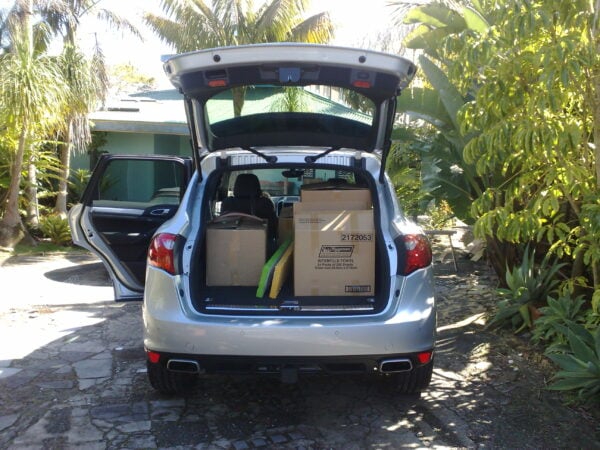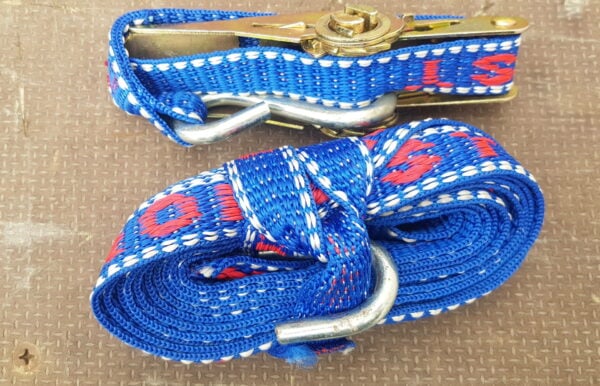To save some money, you can move some or all of your furniture and belongings yourself if you don’t mind a bit of heavy lifting.
Vehicle options:
- Ute
- Van
- Light truck
- Station wagon
- SUV
- Car + trailer
- Car + roof rack
- Class 2 furniture truck (if you have a class 2 licence)
One time, when flatting, I moved house in a Porsche Cayenne that I was writing a review of. Another vehicle I used to move house when I was flatting included an Audi RS6!

Given how unpredictable the weather can be, something with a roof is best, otherwise you’ll need to get some good-quality tarpaulins. A roof also reduces the risk that something will blow away, and it solves the security issue of an open cage trailer.
When you’re planning your move, you’ll need to ensure you have the right packing materials – start storing boxes and spare cardboard for protection. You’ll need ratchet straps to secure the load if you are carrying it in an open trailer or ute, or on a roof rack.

Consumer ratchet straps – usually good for around 200kg of load restraint.
If you’re using straps, you’ll need some old carpet, cardboard, blankets or towels to protect the edges of what you are transporting. Ropes are not advisable to use
Do you know how to safely load and restrain a load?
Every year, hundreds of vehicles roll over because loads are either unbalanced or unrestrained. Even more lose items that then create a danger for other road users. If you don’t know anything about load restraint, this course on loading light vehicles is essential for you to do.
Safe load balance and load security
Before you start loading items, you need a plan. The heaviest items should go at the bottom. Furniture should be disassembled if it’s awkward. Items should be packed so that they can’t move when you brake, accelerate or corner. Use rolled cardboard or bubble wrap to fill spaces where the load will move.
Block loads so that they won’t tip. Tall, heavy loads are better laid on their side so that they don’t tip.
Using a trailer
The best option for a trailer is a covered furniture trailer, but you can also use a cage trailer with load securing straps.
If you are using a trailer, you must keep the load’s centre of gravity in front of the axles, but not too much over the tow ball. If you are loading in a truck or van, keep the heaviest items about halfway between the front and rear wheels.
If the load’s centre of gravity is too far forwards, it puts too much pressure on the towbar, taking grip from the vehicle’s front wheels, meaning steering and braking become less effective.
If the load’s centre of gravity is behind the trailer axles, it causes trailer swing that often results in jackknifing.
You must also know how to connect the trailer securely and be able to understand if the trailer is roadworthy. You must also check that the towing vehicle is capable of pulling the load.
Using a van or truck
The engine is over the front wheels, and that’s already heavy, so in order to keep the balance and not overload the front wheels, the centre of gravity should be just behind the centre of the vehicle. Spread the load out, and make sure that it’s not weighted unequally on one side. Ensure that you understand the legal maximum weight of your vehicle – if you don’t know how to calculate this for a truck, you need to do this vehicle dimensions and mass course.
If you can get a truck with a tail lift, that is the best solution. Tail lift training should be completed before you use it.
Using a roof rack
A roof rack will have a rated capacity that’s fairly light. Ensure that no point loading would cause an issue with bending the roof rack frame.
If carrying a mattress and bed base on the roof rack, load the mattress on the bottom otherwise it tends to fold upwards and create a massive sail.
Be aware of your height if you have to drive under trees in your driveway; don’t accidentally drive into your new garage with your roof rack still loaded!
Using a ute
Because the height of the sides and tailgate of a wellside ute are not very tall, the right load restraint is essential so that items don’t tip over the side. A ute’s side rails are not rated for much load; use the tie-down loops in the tray.
Don’t overload the ute’s tailgate; it’s usually only rated for a couple of hundred kilos.
Checking your load
It’s best to stop after 5km and check that the load hasn’t moved. Resecure anything that’s worked its way loose. Remember that items overhanging the sides of the trailer can cause a hazard to other road users and are illegal if they exceed the maximum distance from the centre line of the vehicle.

